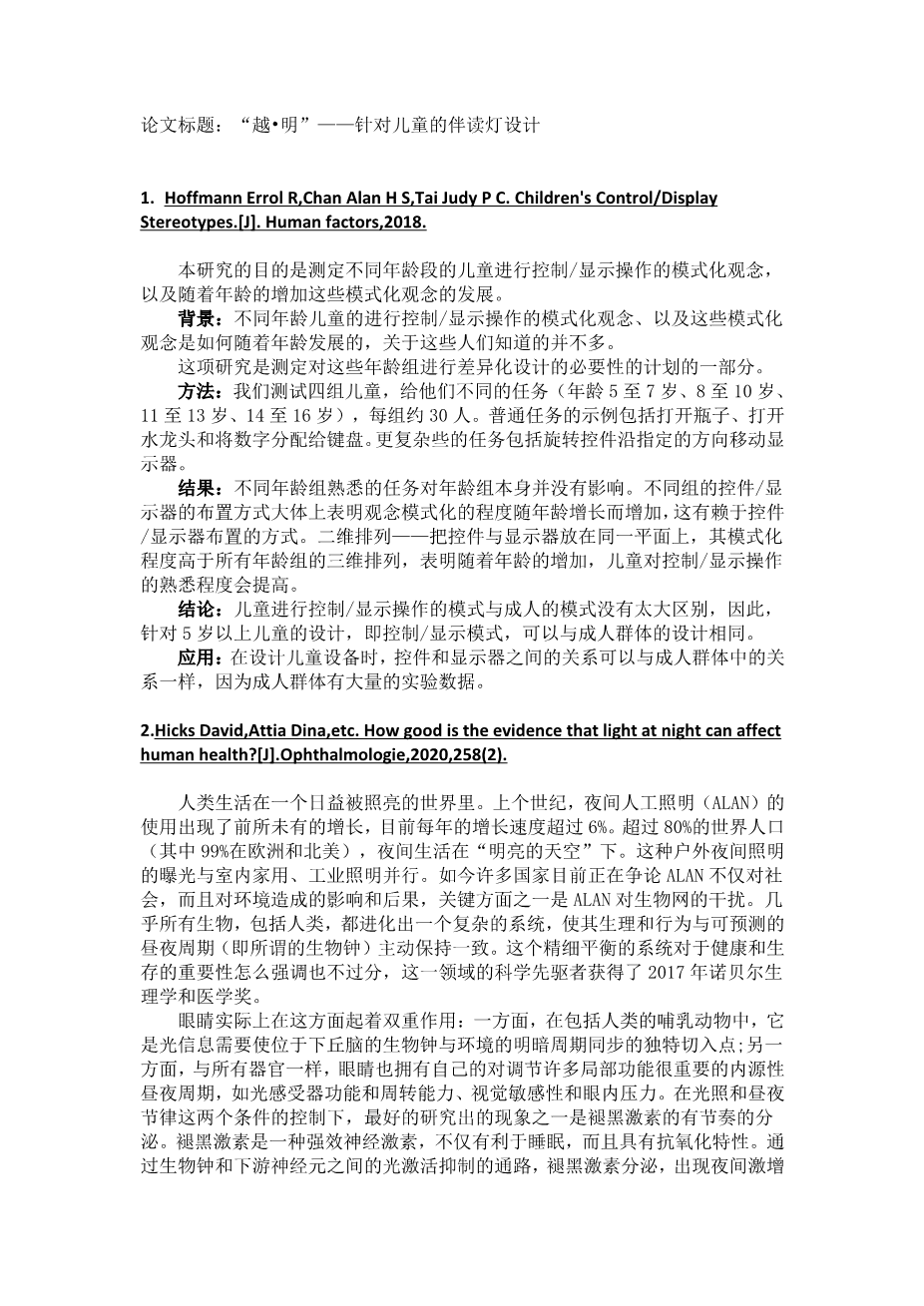文献翻译原文:
1.Hoffmann Errol R,Chan Alan H S,Tai Judy P C. Childrens Control/Display Stereotypes.[J]. Human factors,2018.
The aim of this study was to determine control/display stereotypes for children of a range of ages and development of these stereotypes with age.
Background:Little is known about control/display stereotypes for children of different ages and the way in which these stereotypes develop with age.
This study is part of a program to determine the need to design differentially for these age groups.
Method:We tested four groups of children with various tasks (age groups 5 to 7, 8 to 10, 11 to 13, 14 to 16), with about 30 in each group. Examples of common tasks were opening a bottle, turning on taps, and allocating numbers to keypads. More complex tasks involved rotating a control to move a display in a requested direction.
Results:Tasks with which different age groups were familiar showed no effect of age group. Different control/display arrangements generally showed an increase in stereotype strength with age, with dependence on the form of the control/display arrangement. Two-dimensional arrangements, with the control on the same plane as the display, had higher stereotype strength than three-dimensional arrangements for all age groups, suggesting an effect of familiarity with controls and displays with increasing age.
Conclusion:Childrens control/display stereotypes do not differ greatly from those of adults, and hence, design for children older than 5 years of age, for control/display stereotypes, can be the same as that for adult populations.
Application:When designing devices for children, the relationship between controls and displays can be as for adult populations, for which there are considerable experimental data.
- Hicks David,Attia Dina,etc. How good is the evidence that light at night can affect human health?[J].Ophthalmologie,2020,258(2).
Humans live in an increasingly illuminated world. The last century has seen an unprecedented increase in the use of artificial light at night (ALAN), with a current ongoing increase rate of more than 6% per year. Over 80% of the worldrsquo;s population, with 99% in Europe and North America, lives under alsquo;lit skyrsquo;at night. This exposure to nocturnal illumination outdoors is in parallel to interior domestic and industrial lighting. Many countries are now debating the impact and consequences of ALAN not only upon society but also for the environment. One of the pivotal aspects concerns perturbation of the circadian network by ALAN. Virtually all living organisms including humans have evolved an intricate system enabling their physiology and behavior to be pro-actively aligned with the predictable alternating day-night cycle, the so-called circadian clock. The importance of this finely balanced system for well-being and survival cannot be over-emphasized, and scientific pioneers in this field received the 2017 Nobel Prize for Physiology and Medicine.
The eye actually plays a double role in this context: on the one hand, in mammals including humans, it is the unique entry point of light information necessary to synchronize the master circadian clock located in the hypothalamus with the environmental light-dark cycle; and on the other, like all organs, the eye also possesses its own endogenous circadian clocks which are important in regulating many local functions such as photoreceptor function and turnover, visual sensitivity, and intraocular pressure . One of the best studied phenomena under light and circadian control is the rhythmic secretion of melatonin. Melatonin is a potent neurohormone which not only facilitates sleep but also possesses anti-oxidative properties. Through a light-activated inhibitory pathway between the circadian clock and downstream neurons, there is a nocturnal surge in melatonin secretion and release into the bloodstream and cerebrospinal fluid; exposure to light during the night suppresses melatonin production.It is relatively easy to understand how the circadian system, which has evolved throughout of geological time under bright days alternating with dark nights, can belsquo;confusedrsquo;by exposure to artificial light at a time (evening/night) when it is not present naturally. It has been shown conclusively that in a normal domestic setting, ALAN levels are sufficient to delay onset and/or reduce melatonin secretion, especially in children due to their transparent lenses permitting higher light transmission.
It is hypothesized that ALAN-induced perturbation of the circadian clock, including disruption of melatonin secretion, is very likely involved not only in short-term problems such as decreased drowsiness, sleep quality, and decreased total sleep time but also in longer-term issues like cancer, mental health, cognitive performance, obesity and weight gain, type 2 diabetes and coronary heart disease (coronary ischemia and myocardial infarction), and possible effects on dyslipidemia, arterial hypertension, and ischemic stroke.
Much less investigated are any direct effects of ALAN upon ocular health, which could also be of two non-mutually exclusive types: either through phototoxicity (light damage) to photoreceptors or via perturbation of the ocular circadian system which would then impact a wide range of processes. For example, a single night of moderate light exposure in diurnal rodents leads to widespread alteration in expression of circadian clock genes, “output”genes involved in phototransduction, and cellular activities like rhythmic photoreceptor phagocytosis. Furthermore, phototoxicity itself is partly under circadian control, since exposure of rats to intense light is more injurious when performed at night than during the day.
Light-emitting
剩余内容已隐藏,支付完成后下载完整资料

英语译文共 4 页,剩余内容已隐藏,支付完成后下载完整资料
资料编号:[254367],资料为PDF文档或Word文档,PDF文档可免费转换为Word


